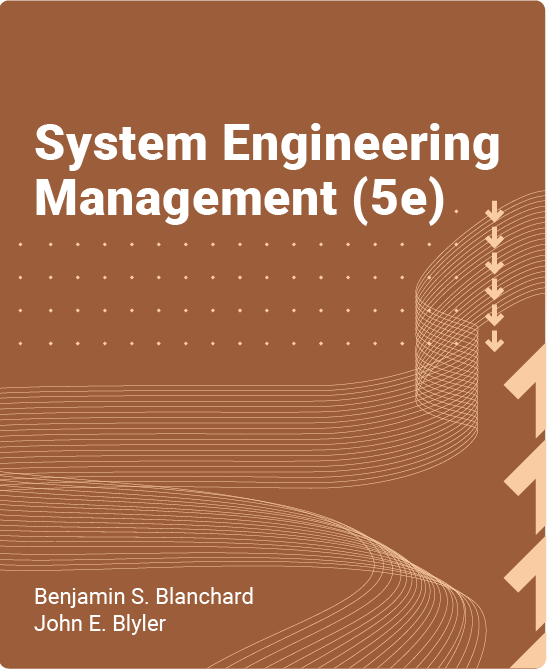Table of Contents
1 Introduction to System Engineering
1.1 Definition of a System
1.1.1 The Characteristics of a System
1.1.2 Categories of Systems
1.1.3 System of Systems (SOS)
1.2 The Current Environment: Some Challenges
1.3 The Need for System Engineering
1.3.1 The System Life Cycle
1.3.2 Definition of System Engineering
1.3.3 Requirements for System Engineering
1.3.4 System Architecture
1.3.5 System Science
1.3.6 System Analysis
1.3.7 Some Additional System Models
1.3.8 System Engineering in the Life Cycle (Some Applications)
1.4 Related Terms and Definitions
1.4.1 Concurrent/Simultaneous Engineering
1.4.2 Some Major Supporting Design Disciplines
1.4.3 Logistics and Supply-Chain Management (SCM)
1.4.4 Integrated System Maintenance and Support
1.4.5 Data and Information Management
1.4.6 Configuration Management (CM)
1.4.7 Total Quality Management (TQM)
1.4.8 Total System Value and Life-Cycle Cost (LCC)
1.4.9 Some Additional Terms And Definitions
1.5 System Engineering Management
1.6 Summary
2 The System Engineering Process
2.1 Definition of the Problem (Current Deficiency)
2.2 System Requirements (Needs Analysis)
2.3 System Feasibility Analysis
2.4 System Operational Requirements
2.5 The Logistics and Maintenance Support Concept
2.6 Identification and Prioritization of Technical Performance Measures (TPMs)
2.7 Functional Analysis
2.7.1 Functional Flow Block Diagrams (FFBDs)
2.7.2 Operational Functions
2.7.3 Maintenance and Support Functions
2.7.4 Application of Functional Analysis
2.7.5 Interfaces with Other Systems in a SOS Configuration
2.8 Requirements Allocation
2.8.1 Functional Packaging and Partitioning
2.8.2 Allocation of System-Level Requirements to the Subsystem Level and Below
2.8.3 Traceability of Requirements (Top-Down/Bottom-Up)
2.8.4 Allocation of Requirements in a SOS Configuration
2.9 System Synthesis, Analysis, and Design Optimization
2.10 Design Integration
2.11 System Test and Evaluation
2.11.1 Categories of Test and Evaluation
2.11.2 Integrated Test Planning
2.11.3 Preparation for Test and Evaluation
2.11.4 Test Performance, Data Collection, Analysis, and Validation
2.11.5 System Modifications
2.12 Production and/or Construction
2.13 System Operational Use and Sustaining Support
2.14 System Retirement and Material Recycling/Disposal
3 System Design Requirements
3.1 Development of Design Requirements and Design-To Criteria
3.2 Development of Specifications
3.3 The Integration of System Design Activities
3.4 Selected Design Engineering Disciplines
3.4.1 Software Engineering
3.4.2 Reliability Engineering
3.4.3 Maintainability Engineering
3.4.4 Human-Factors Engineering
3.4.5 Safety Engineering
3.4.6 Security Engineering
3.4.7 Manufacturing and Production Engineering
3.4.8 Logistics and Supportability Engineering
3.4.9 Disposability Engineering
3.4.10 Quality Engineering
3.4.11 Environmental Engineering
3.4.12 Value/Cost Engineering (Life-Cycle Costing)
3.5 SOS Integration and Interoperability Requirements
3.6 Summary
4 Engineering Design Methods and Tools
4.1 Conventional Design Practices
4.2 Analytical Methods
4.3 Information Technology, the Internet, and Emerging Technologies
4.4 Current Design Technologies and Tools
4.4.1 The Use of Simulation in System Engineering
4.4.2 The Use of Rapid Prototyping
4.4.3 The Use of Mock-Ups
4.5 Computer-Aided Design (CAD)
4.6 Computer-Aided Manufacturing (CAM)
4.7 Computer-Aided Support (CAS)
4.8 Summary
5 Design Review and Evaluation
5.1 Design Review and Evaluation Requirements
5.2 Informal Day-to-Day Review and Evaluation
5.3 Formal Design Reviews
5.3.1 Conceptual Design Review
5.3.2 System Design Reviews
5.3.3 Equipment/Software Design Reviews
5.3.4 Critical Design Review
5.4 The Design Change and System Modification Process
5.5 Supplier Review and Evaluation
5.6 Summary
6 System Engineering Program Planning
6.1 System Engineering Program Requirements
6.1.1 The Need for Early System Planning
6.1.2 Determination of Program Requirements
6.2 System Engineering Management Plan (SEMP)
6.2.1 Statement of Work
6.2.2 Definition of System Engineering Functions and Tasks
6.2.3 System Engineering Organization
6.2.4 Development of a Work Breakdown Structure (WBS)
6.2.5 Specification/Documentation Tree
6.2.6 Technical Performance Measures (TPM)
6.2.7 Development of Program Schedules
6.2.8 Preparation of Cost Projections
6.2.9 Program Technical Reviews and Audits
6.2.10 Program Reporting Requirements
6.3 Determination of Outsourcing Requirements
6.3.1 Identification of Potential Suppliers
6.3.2 Development of a Request for Proposal (RFP)
6.3.3 Review and Evaluation of Supplier Proposals
6.3.4 Selection of Suppliers and Contract Negotiation
6.3.5 Supplier Monitoring and Control
6.4 Integration of Design Specialty Plans
6.5 Interfaces with Other Program Activities
6.5.1 Interface Management
6.6 Management Methods/Tools
6.7 Risk Management Plan
6.8 Global Applications/Relationships
6.9 Summary
7 Organization for System Engineering
7.1 Developing the Organizational Structure
7.2 Customer, Producer, and Supplier Relationships
7.3 Customer Organization and Functions
7.4 Producer Organization and Functions (the Contractor)
7.4.1 Functional Organization Structure
7.4.2 Product-Line/Project Organization Structure
7.4.3 Matrix Organizational Structure
7.4.4 Integrated Product and Process Development (IPPD)
7.4.5 Integrated Product/Process Teams (IPTs)
7.4.6 System Engineering Organization
7.5 Tailoring the Process
7.5.1 Tailoring the Process
7.5.2 Middle-Out Approach
7.5.3 Managing from the Middle
7.6 Supplier Organization and Functions
7.6.1 Mapping Organization and Systems Structures
7.7 Human Resource Requirements
7.7.1 Creating the Proper Organizational Environment
7.7.2 Leadership Characteristics
7.7.3 The Needs of the Individual
7.7.4 Staffing the Organization
7.7.5 Personnel Development and Training
7.8 Summary
8 System Engineering Program Evaluation
8.1 Evaluation Requirements
8.2 Benchmarking
8.3 Evaluation of the System Engineering Organization
8.4 Program Reporting, Feedback, and Control
8.5 Summary
Appendix A Functional Analysis (Case-Study Examples)
Appendix B Cost Process and Models
Appendix C Selected Case Studies (Nine Examples)
Appendix D Design Review Checklist
Appendix E Supplier Evaluation Checklist
Appendix F Selected Bibliography
zyText are leading print textbooks available in full on the zyBooks platform. Each zyText has been adapted to include learning questions and answer-specific feedback allowing for a quick and easy transition to an engaging digital experience for instructors and students.
What You’ll Find In This zyText:
- Incorporates the complete text
- Over 150 learning questions with answer-specific feedback
- Customization tools letting you add, remove or reorder chapters and sections
- Options to align the book directly to your syllabus – including videos, images, text
- Analytics that help you measure student engagement
- Ability to hold students accountable for reading before class
- A competitive low price point
- Students can keep a PDF version of key chapters at no additional cost
With emphasis on practical aspects of engineering, this bestseller has gained worldwide recognition
through progressive editions as the essential reliability textbook.
Practical Reliability Engineering fulfils the requirements of the Certified Reliability Engineer
curriculum of the American Society for Quality (ASQ).
Includes:
- Applications of Monte Carlo simulation methods and reliability demonstration methods.
- Software applications of statistical methods, including probability plotting and a wider use of
common software tools. - Detailed descriptions of reliability prediction methods.
- Comprehensive treatment of accelerated test data analysis and warranty data analysis.
Authors
Benjamin S. Blanchard and John E. Blyler

